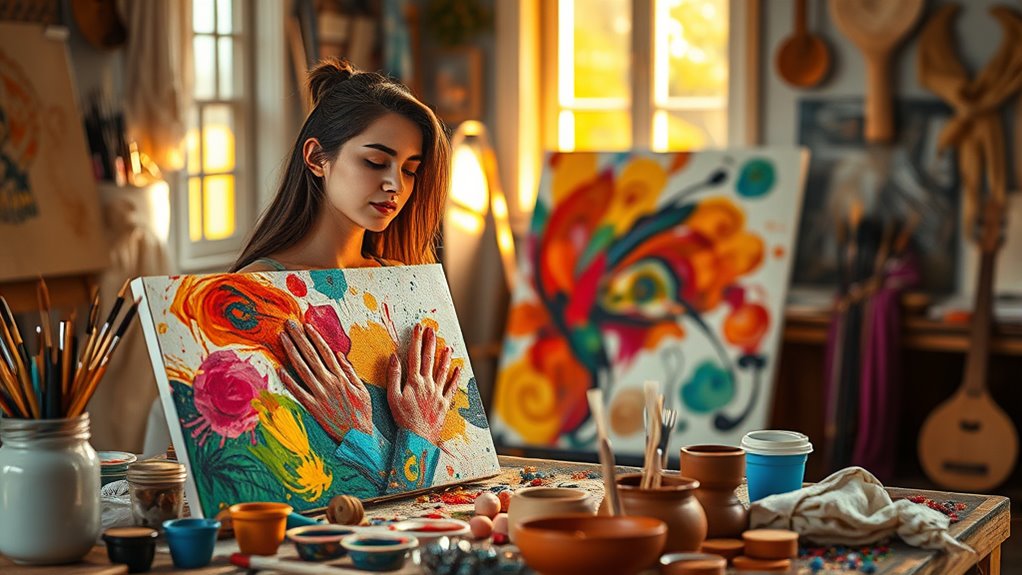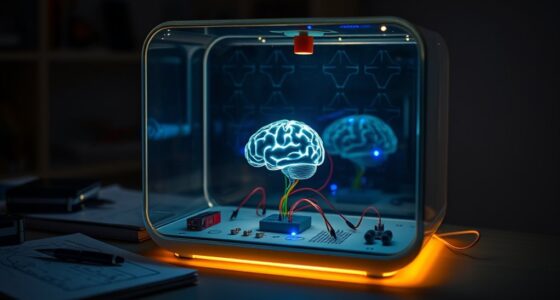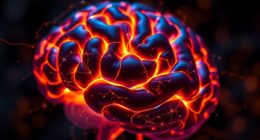Expressive arts therapy offers a powerful way for you to release emotional tension and promote healing through creative activities like drawing, music, dance, or writing. It helps you access deeper feelings, externalize difficult emotions, and process them in a safe, supportive environment. This approach encourages free self-expression without judgment, fostering self-awareness and emotional resilience over time. If you explore further, you’ll discover how this creative process can lead to lasting emotional release and personal growth.
Key Takeaways
- Facilitates emotional release by externalizing feelings through creative activities like drawing, painting, or music.
- Bypasses verbal communication, accessing subconscious emotions for deeper self-awareness and insight.
- Creates a safe environment for expressing difficult emotions such as anger, sadness, or anxiety.
- Promotes mindfulness and present-moment focus, aiding in stress reduction and mood improvement.
- Encourages ongoing self-expression techniques like journaling or art to support long-term emotional well-being.

Have you ever wondered how creative expression can promote healing and self-discovery? When you engage in expressive arts therapy, you tap into a powerful tool for emotional release and personal growth. This approach isn’t just about making art; it’s about allowing your inner feelings to surface and be processed in a safe, supportive environment. Art therapy benefits are wide-ranging, offering more than just a creative outlet. They include reduced stress, improved mood, and enhanced self-awareness. These benefits arise because expressive arts therapy integrates various creative expression techniques, such as drawing, painting, music, dance, and writing, enabling you to explore emotions that might be difficult to articulate with words alone.
Using creative expression techniques, you bypass the logical mind and access deeper layers of your subconscious. This process often leads to revelations about yourself and your emotional state that you might not have discovered otherwise. For example, creating a visual piece can help you externalize feelings of anger, sadness, or anxiety, giving you a tangible form to work through. The act of art-making encourages mindfulness and focus, helping you stay present with your emotions rather than avoiding or suppressing them. As you engage in these techniques, you create a cathartic release, allowing pent-up feelings to flow out in a safe and controlled manner. Incorporating different materials and mediums can further enhance this process by providing new avenues for expression and exploration.
Creative techniques reveal hidden emotions and promote mindfulness through safe, cathartic self-expression.
The beauty of expressive arts therapy is that it doesn’t require you to be an artist or have any special skills. It’s about the process, not the product. You’re encouraged to express yourself freely, without judgment or expectation. This freedom fosters a sense of empowerment and self-compassion as you realize that your emotions are valid and worthy of attention. As you continue to explore different creative techniques, you learn new ways to cope with stress and emotional pain, building resilience over time.
Furthermore, engaging in these activities regularly can help you develop healthier ways to manage your emotions outside of therapy sessions. You might find that painting, dancing, or journaling becomes an outlet for processing daily stresses or complex feelings. Over time, this consistent practice deepens your self-awareness and emotional intelligence. Ultimately, the integration of art therapy benefits with diverse creative expression techniques allows you to connect with your inner world, fostering emotional release and guiding you toward healing and self-discovery.
Frequently Asked Questions
Can Expressive Arts Therapy Help With Severe Mental Health Issues?
Yes, expressive arts therapy can help with severe mental health issues by fostering creative expression and emotional healing. You actively engage in art, music, dance, or drama, which allows you to process feelings safely and gain insights. This approach supports emotional release, reduces stress, and promotes resilience. While it may not replace traditional treatments, it complements them effectively, helping you manage symptoms and achieve greater mental well-being.
What Age Groups Benefit Most From Expressive Arts Therapy?
You might think only kids or the elderly benefit from expressive arts therapy, but you’d be wrong—everyone in between can gain from it. Adolescents, steering through identity and development, find it a safe outlet, while the elderly, seeking engagement and meaning, thrive through creative expression. So, don’t limit yourself—this therapy’s age flexibility makes it a powerful tool for emotional release across all stages of life.
How Long Does It Typically Take to See Results?
You might start seeing progress within a few sessions, but the timeline varies based on individual differences. Some people notice emotional releases early on, while others need more time to process and express feelings through art. Patience is key, and consistent participation helps. Typically, with regular therapy, you can expect noticeable improvements within a few months, but everyone’s progress timeline is unique, depending on personal experiences and engagement level.
Are There Any Risks or Contraindications Involved?
You might find it surprising, but expressive arts therapy generally poses low risks if emotional safety is prioritized. However, some artistic limitations could trigger emotional discomfort or overwhelm, especially with intense feelings. It’s essential to work with a trained therapist who can guide you safely through the process, ensuring your emotional safety while respecting your artistic boundaries. Always communicate your limits to prevent unintended distress or contraindications.
How Do I Find a Qualified Expressive Arts Therapist Near Me?
To find a qualified expressive arts therapist near you, start by checking local directories like Psychology Today or TherapyTribe. Make sure they meet certification requirements, such as holding credentials from recognized organizations like the ART (Expressive Arts Therapy) credential. You can also contact local mental health clinics or community centers for recommendations. Verifying their experience in expressive arts therapy guarantees you get professional, effective support tailored to your needs.
Conclusion
By engaging in expressive arts therapy, you unfasten your emotions like a key opening a chest full of hidden feelings. It’s a powerful tool that helps you release pent-up emotions and find clarity amid chaos. Just as a river flows freely around obstacles, your feelings can move and transform through creative expression. Embrace this journey, and you’ll discover a deeper understanding of yourself, opening the door to healing and emotional freedom you never knew was possible.









